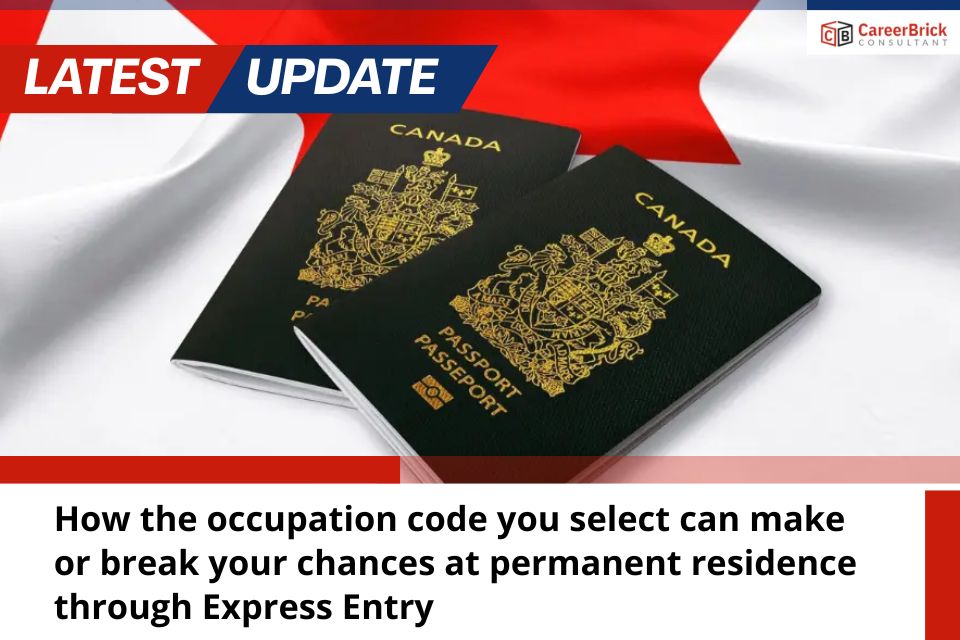For many foreign nationals, switching to a more in-demand career could significantly increase their chances of receiving an Invitation to Apply (ITA) for Canadian permanent residence (PR) through Express Entry.
If you don’t have a provincial nomination, lack strong French language skills, or don’t meet the high Comprehensive Ranking System (CRS) score typically required for the Canadian Experience Class (CEC), pursuing work experience in a targeted occupation may be your best option.
Category-Based Express Entry Draws: A Path with Lower Cut-Offs
Category-based draws are a recent addition to Express Entry, designed to select candidates who meet specific occupational or skill-based criteria. These draws often have lower CRS cut-off scores compared to general or CEC draws.
To qualify for a category-based draw, candidates must have at least six months of continuous, full-time (or equivalent part-time) work experience in a single eligible occupation within one of the selected categories.
In this article, we've highlighted some of the most accessible occupations that can help you quickly gain the required work experience for category-based eligibility.
Overview of Easiest Occupations to Break Into
The table below outlines occupations that are relatively easy to enter, including the typical time it takes to qualify and begin working, the CRS cut-off score from the most recent draw for each category, median pay across Canada, and whether the occupation is eligible for a Spousal Open Work Permit (SOWP).
|
Occupation |
Time to Qualify |
CRS Cut-Off (Latest Draw) |
Category |
Median Hourly Pay |
SOWP Eligible? |
|
Elementary and Secondary School Teacher Assistants (43100) |
10 months – 2 years |
479 (May 1, 2025) |
Education |
$24.36 |
Yes |
|
Insurance Agents and Brokers (63100) |
A few weeks – a few months |
491 (April 11, 2024) |
STEM |
$29.77 |
No |
|
Medical Laboratory Assistants and Related (33101) |
1 – 2 years |
510 (May 2, 2025) |
Healthcare & Social Services |
$26.35 |
Yes |
|
Nurse Aides and Patient Service Associates (33102) |
No training required |
N/A |
$23.00 |
Yes |
|
|
Pharmacy Technical & Assistants (33103) |
No training required |
N/A |
$20.00 |
Yes |
|
|
Cooks (63200) |
No training required |
433 (Oct 23, 2024) |
Trades |
$17.00 |
No |
|
Concrete Finishers (73100) |
No training required |
N/A |
$32.76 |
Yes |
|
|
Floor Covering Installers (73113) |
No training required |
N/A |
$26.92 |
Yes |
|
|
Roofers and Shinglers (73110) |
No training required |
N/A |
$30.00 |
Yes |
|
|
Painters and Decorators (Except Interior Decorators) |
No training required |
N/A |
$26.00 |
Yes |
|
|
Butchers – Retail and Wholesale (63201) |
No training required |
437 (Feb 16, 2024) |
Agriculture & Agri-Food |
$19.50 |
No |
Note: Time to qualify may vary by province or territory due to differing regulatory requirements.
Key Takeaways
While many of these occupations allow you to start working immediately, others may require short-term training or certification. Exceeding the minimum requirements can improve your employment prospects—especially in more competitive regions or industries.
In the sections below, we’ll explore each occupation in greater detail, including typical job responsibilities, training pathways, and regional demand.
Elementary and Secondary School Teacher Assistants
Category: Education
NOC Code: 43100
Median Pay: $24.36/hour
Role Overview:
Teacher assistants play a vital role in supporting classroom learning. They help students with assignments, provide support to those with special needs, supervise classroom and recreational activities, and assist teachers with tasks such as setting up educational equipment and materials.
Pathway to Employment:
To work as a teacher assistant, you must have completed secondary school.
Additionally, most employers require completion of a post-secondary program in teaching or educational assistance, or a related field such as social sciences. These programs typically take between 10 months and 2 years to complete.
Other common requirements include:
- CPR and First Aid Certification – Often required and can be completed in just a few days.
- Specialized Training – Positions involving support for students with special needs may require additional, specialized certifications.
Insurance Agents and Brokers
Category: STEM
NOC Code: 63100
Median Pay: $29.77/hour*
Role Overview:
Insurance agents represent a specific insurance provider, helping clients select suitable policies. Brokers, on the other hand, work independently to find the best insurance solutions across multiple companies. While both roles involve selling insurance products, they differ in licensing, responsibilities, and client representation.
Pathway to Employment:
A secondary school diploma is the minimum requirement.
To become licensed, you must:
- Complete a provincial licensing course
- Pass a qualifying exam specific to your insurance specialization:
- OTL (Other Than Life) – General insurance agents
- LLQP (Life License Qualification Program) – Life insurance agents
- RIBO – Brokers in Ontario
Once you pass the exam, you must:
- Apply for a licence through your provincial insurance regulator
- Pay the necessary licensing fees
- In some provinces (e.g., Ontario), secure sponsorship from an insurance company (for agents)
Maintaining Your Licence:
Licensed professionals must renew their licence regularly and meet ongoing regulatory requirements.
Note: Compensation in this field is often commission-based. Life insurance roles are typically 100% commission, whereas property insurance roles may include a base salary plus commission.
Medical Laboratory Assistants and Related Technical Occupations
Category: Healthcare and Social Services
NOC Code: 33101
Median Pay: $26.35/hour
Role Overview:
Medical laboratory assistants are responsible for collecting, labeling, and preparing biological samples for testing. They also log patient data, verify sample details, and help set up laboratory equipment for diagnostic procedures.
Pathway to Employment:
To enter this field, you must have completed secondary school.
In addition, you'll typically need to complete a college certification program in medical laboratory science. These programs can take anywhere from less than one year to two years to complete.
Certification from professional bodies may also be required or preferred by employers, such as:
- Ontario Society of Medical Technologists (OSMT)
- Canadian Society for Medical Laboratory Science (CSMLS)
To obtain certification, you must usually complete an approved program and pass a qualifying exam.
Nurse Aides, Orderlies, and Patient Service Associates
Category: Healthcare and Social Services
NOC Code: 33102
Median Pay: $23/hour
Role Overview:
This group of healthcare workers provides essential support to patients by assisting with daily living activities—such as bathing, feeding, and mobility—as well as basic medical tasks like recording vital signs and documenting care.
Pathway to Employment:
To qualify for this role, one of the following is generally required:
- Some secondary school education and on-the-job training
- Completion of a personal support worker (PSW), nursing aide, or healthcare aide program
- Graduation from a college nursing orderly program, which includes supervised practical training
Additional qualifications that may be requested by employers include:
- CPR and First Aid Certification (usually obtainable in one day)
- A valid driver’s licence, especially for roles involving home care or travel
Pharmacy Technical Assistants and Pharmacy Assistants
Category: Healthcare and Social Services
NOC Code: 33103
Median Pay: $20/hour
Role Overview:
Pharmacy assistants support pharmacists by entering prescription data, preparing and labeling medications, managing inventory, handling medical billing, and organizing stock. Pharmacy technical assistants may also be involved in more technical dispensing tasks under pharmacist supervision.
Pathway to Employment:
There are two common ways to enter this occupation:
- Complete a Pharmacy Assistant college program, typically lasting 6–12 months
- Finish secondary school followed by several months of on-the-job training
To become a Pharmacy Technical Assistant, you’ll typically need to complete a vocational program lasting up to two years.
Cooks
Category: Trades
NOC Code: 63200
Median Pay: $17/hour
Role Overview:
Cooks prepare and cook meals, oversee kitchen operations, supervise kitchen staff, and manage inventory and food supplies. They play a crucial role in maintaining food quality, hygiene, and kitchen efficiency.
Pathway to Employment:
While secondary school education is beneficial, it is not mandatory. Entry into this field can be achieved through one of the following routes:
- Completion of a three-year apprenticeship program
- Graduation from a college or culinary program
- Several years of hands-on experience in a commercial kitchen
Some employers may also require a food handler’s certificate, which can typically be obtained in just a few days.
Although cooking certifications are voluntary across Canada, experienced cooks can pursue the Red Seal endorsement by passing the interprovincial Red Seal exam—an industry-recognized credential that can enhance job mobility and earning potential.
Concrete Finishers
Category: Trades
NOC Code: 73100
Median Pay: $32.76/hour
Role Overview:
Concrete finishers are responsible for leveling, smoothing, and finishing freshly poured concrete on surfaces such as floors, sidewalks, roads, and curbs. They use both hand and power tools to achieve specific textures and finishes, install fixtures, and apply sealants or waterproofing compounds as needed.
Pathway to Employment:
While secondary school education is generally considered an asset, it is not mandatory. You can begin working in this field without formal training, learning skills on the job.
To pursue trade certification (which is voluntary in most provinces and territories, except Quebec), you’ll need to either:
- Complete a two- to four-year apprenticeship program; or
- Have at least three years of relevant work experience, along with some formal training or courses in cement finishing.
Floor Covering Installers
Category: Trades
NOC Code: 73113
Median Pay: $26.92/hour
Role Overview:
Floor covering installers are skilled tradespeople who measure, cut, and install a range of floor coverings, including carpet, hardwood, laminate, tile, and vinyl. They use tools like stretchers, rollers, knives, and adhesives, and may also inspect, repair, or provide cost estimates for flooring jobs.
Pathway to Employment:
You can start working in this occupation directly, and having completed secondary school can be an added advantage.
For those aiming for trade certification, the following pathways apply:
- Completion of a two- to three-year apprenticeship program; or
- A minimum of four years of work experience, plus some formal coursework in floor covering installation.
Trade certification is mandatory only in Quebec and voluntary in all other provinces and territories.
A Red Seal endorsement is also available upon successful completion of the interprovincial Red Seal exam, which can increase employment opportunities across Canada.
Painter and Decorator (Excludes Interior Decorator)
Category: Trades
NOC Code: 73112
Median Pay: $26/hour
Role Overview:
Painters and decorators enhance and protect interior and exterior surfaces by preparing and painting them. This includes cleaning and sanding surfaces, removing wallpaper and loose paint, repairing cracks or holes, and mixing paints to achieve specific colors and textures. They may also advise clients on paint types and wall coverings, as well as provide cost estimates for projects.
Pathway to Employment:
You can enter this occupation without formal education, though secondary school completion is generally beneficial.
To obtain trade certification (which is voluntary outside Quebec), you’ll need to:
- Complete a three- to four-year apprenticeship program; or
- Accumulate at least three years of work experience in the trade.
Roofers and Shinglers
Category: Trades
NOC Code: 73110
Median Pay: $30/hour
Role Overview:
Roofers and shinglers are responsible for installing, repairing, and replacing various types of roofing systems, including shingles, tiles, and membranes. Their duties also involve preparing roof surfaces, ensuring proper insulation and waterproofing, setting up scaffolding for safe access, and estimating material needs and project costs.
Pathway to Employment:
For both roles, secondary school education is considered an asset, but not mandatory.
To become a certified roofer, you’ll typically need to:
- Complete a two- to three-year apprenticeship program; or
- Gain at least three years of hands-on work experience in the field.
Certification is voluntary in most provinces and territories except Quebec.
Shinglers, in particular, often enter the field through one to two years of on-the-job training, rather than formal apprenticeship programs.
Butchers – Wholesale and Retail
Category: Agriculture and Agri-Food
NOC Code: 63201
Median Pay: $19.50/hour
Role Overview:
Butchers and meat cutters handle the preparation, cutting, and packaging of meat, poultry, and seafood for retail sale or custom orders. They also maintain inventory, manage displays, and ensure compliance with food safety standards.
Pathway to Employment:
You can enter this occupation immediately, although having completed secondary school is advantageous.
That said, many employers may prefer candidates who have:
- Completed a butchery training program at a college or vocational institution (duration: 4 weeks to several months);
- Food safety certification; and/or
- Previous relevant experience.
Eligibility for Category-Based Express Entry Draws
To receive an Invitation to Apply (ITA) through a category-based round of Express Entry, candidates must:
- Meet the minimum eligibility criteria for Express Entry and qualify under one of its three main programs (CEC, FSWP, or FSTP);
- Have at least six months of continuous, full-time work experience (or equivalent part-time experience) within the past three years in one eligible occupation from a targeted category;
- Fulfill all other requirements specified in the instructions for that particular draw.
Note:
This article focuses on occupations within Training, Education, Experience, and Responsibilities (TEER) level 3, which typically require:
- A college diploma,
- Apprenticeship training (less than two years), or
- More than six months of on-the-job training.
Example Scenario: Brian
Brian, a 26-year-old media professional, is working in Canada on a post-graduation work permit. He qualifies under the Canadian Experience Class (CEC) program in Express Entry.
At present, Brian has:
- A CRS score of 470,
- A bachelor’s degree,
- One year of Canadian work experience,
- Two years of foreign experience, and
- CLB 9 in English across all abilities.
Unfortunately, his score hasn't been high enough to receive an ITA under any of the 2025 CEC-specific draws.
To improve his chances, Brian:
- Applies for and receives a study permit,
- Enrolls in a college program in Education,
- Gains six months of continuous, full-time work experience as a teaching assistant.
This boosts his CRS score to 505.
As a result, Brian becomes eligible for the Education category-based draw held on May 1, where the CRS cut-off score was 479.
If IRCC conducts a similar Education draw in the near future with a comparable cut-off, Brian would be in a strong position to receive an ITA and move forward with his PR application.







